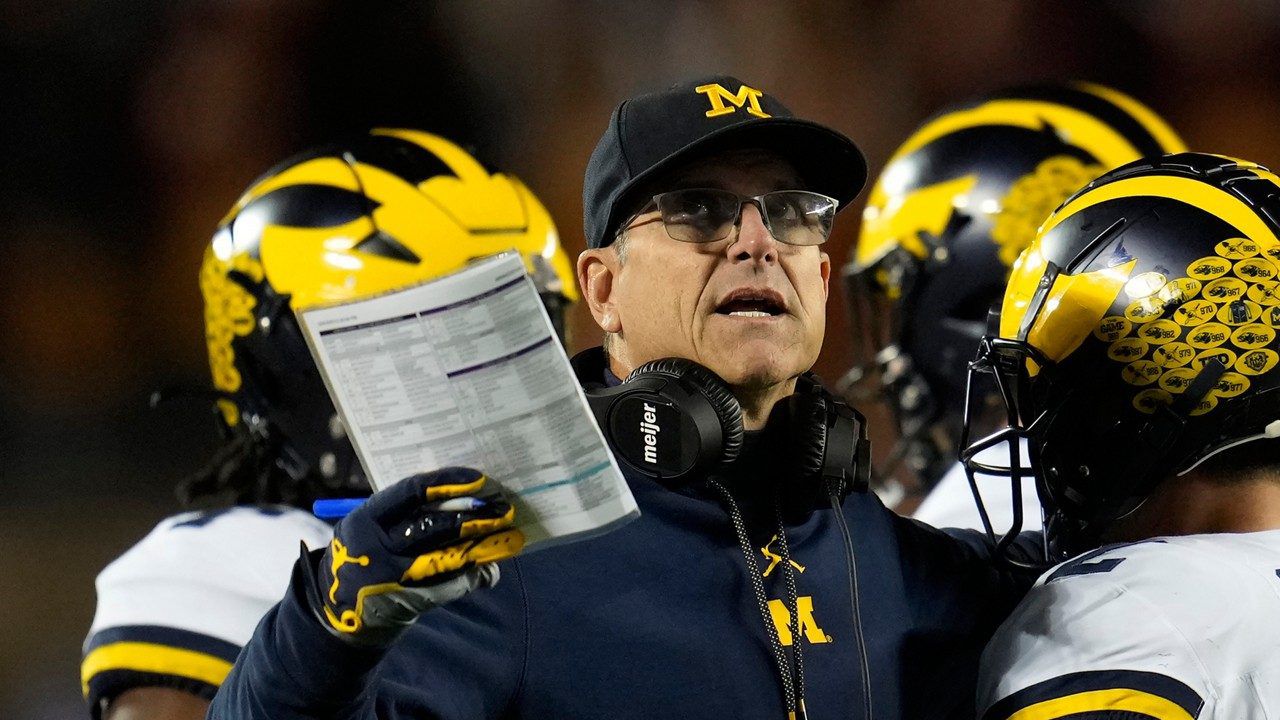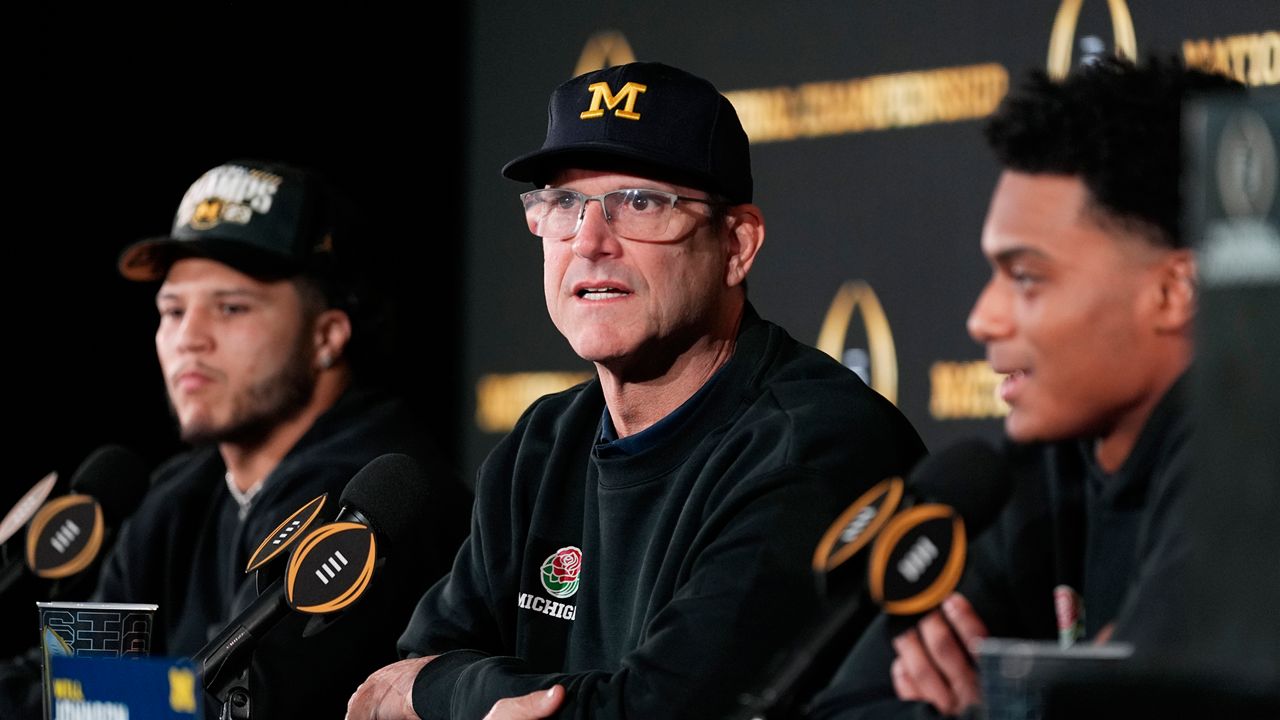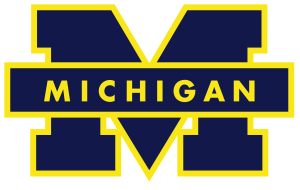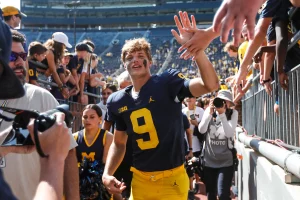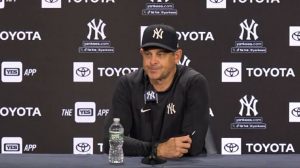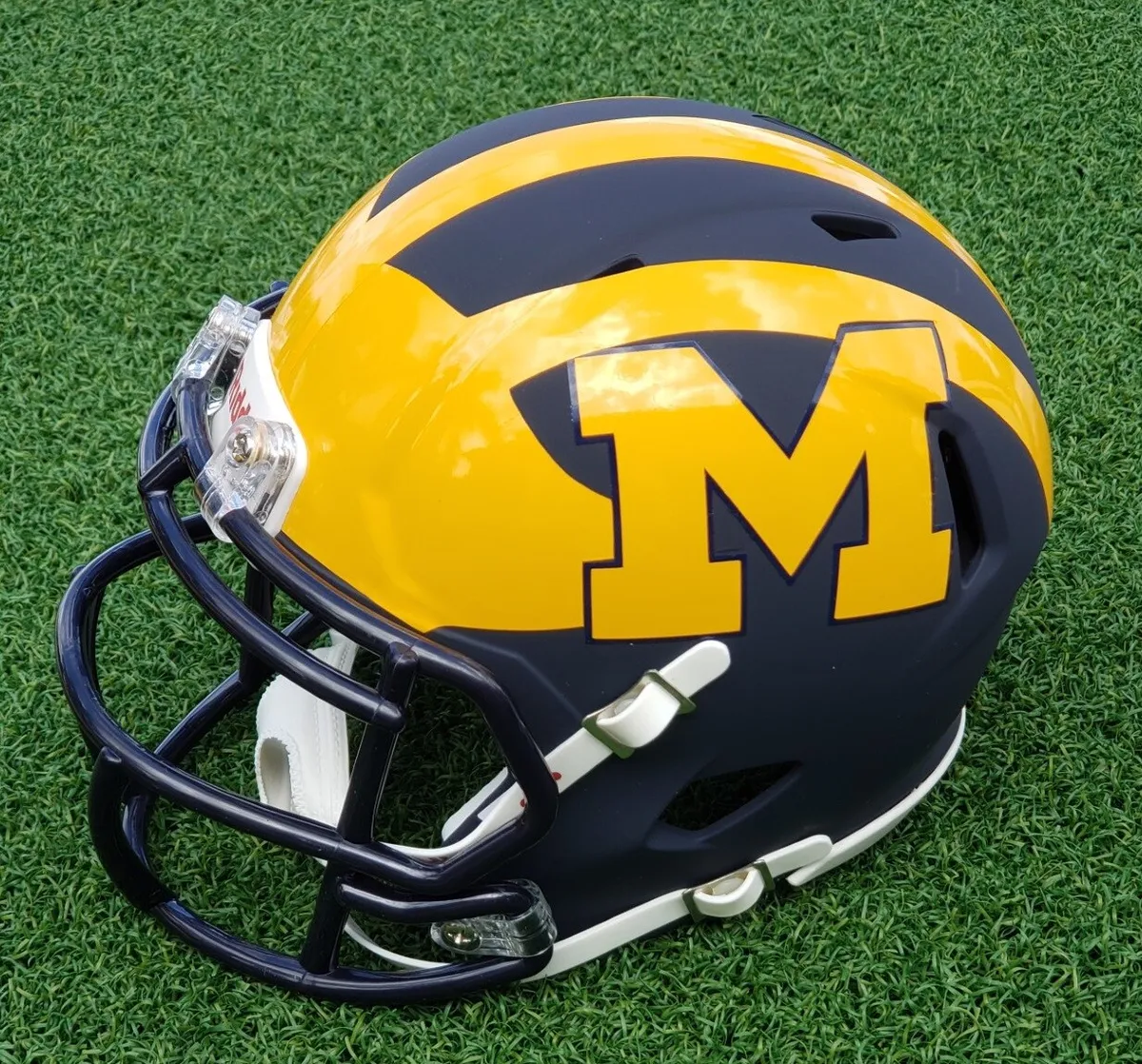
First-look 2024 Michigan depth chart: How the Wolverines will replace 10 offensive starters from 2023
We look at who we would currently project to start, backup and mix in at each offensive position group for the Michigan football team.
These days, there truly never seems to be a dull moment in college football, especially for the Michigan football team.
In the last week, the Wolverines have captured a national title, celebrated that title with a televised parade and indoor celebration, had players enter the NCAA Transfer Portal and seen nearly two dozen players make NFL Draft decisions. But beginning Tuesday, those decision deadlines have passed, giving us a chance to take a fresh look at where things stand for the Wolverines as they begin to prepare for the 2024 season.
Our first method of doing so is with a first-look depth chart. Keeping score on which players have arrived and departed, we look at who we would currently project to start, backup and mix in at each offensive position group. We also break down where things stand, including a Transfer Portal need meter.
As always, we don’t do ties with our depth charts, but may explain our reasoning for picking one player over another. For this edition, we’re sticking to returning players, and enrolled transfers and recruits only. We also aren’t projecting breakout players who could make a move in August just yet, but rather sticking to what the Wolverines would go with if they had a month to prepare for a game.
With that, let’s dive in on the offense, which must replace its starting quarterback, running back, top two wide receivers and top six offensive linemen.
Starter: Redshirt sophomore Jayden Denegal
Backup: Redshirt sophomore Alex Orji
In the mix: Freshman Jadyn Davis, redshirt junior Davis Warren
Who’s out: JJ McCarthy, Jack Tuttle
Who’s in: Davis (No. 93 in the 247Sports Composite, No. 7 quarterback)
Transfer need: 9 out of 10
Why this order: There are arguably more question marks surrounding Michigan’s quarterback room alone than the Wolverines’ entire roster this time a year ago, so this order should not be viewed as permanent.
(This story continues below.)
But from our time viewing snippets of practices over the past month, we give Denegal the slight edge, as he came off as a slightly more polished and confident passer. Orji played more snaps than Denegal down the home stretch of the season (Denegal played 28 snaps to Orji’s 17 during the whole season), but most of those were in a run-first role. He may be objectively Michigan’s best athlete on the team, but he did not attempt a pass this season and has one completion for five yards through two seasons.
Denegal went 4 for 5 this season for 50 yards and a touchdown, and seemed to pass Warren as Michigan’s No. 3 quarterback behind McCarthy and Tuttle. That may not seem like much, but Orji played 17 snaps this year and didn’t attempt a pass; is Michigan sold on him as QB1 for a team trying to defend a national title?
We’re intrigued by Davis, who finished the 2024 cycle as a top-100 recruit and won two MaxPrep North Carolina Player of the Year awards while throwing for 6,975 yards, 11.5 yards per attempt, 86 touchdowns, 15 interceptions and a 71.7 completion percentage over the last two years. He may have fallen off five-star status, but Michigan isn’t discouraged. That said, we’ll wait to see how spring practices go before setting too many year-one expectations.for him. Remember: Jim Harbaugh had both Andrew Luck and JJ McCarthy wait a year before earning starting jobs.
As a room, Michigan’s quarterbacks have great arm strength and athleticism, and all three quarterbacks have high, high potential. But with a combined 10 collegiate completions between the above-listed quarterback candidates, this room enters the spring with a lot to prove, and plenty of room to add a transfer.
Running back
Starter: Senior Donovan Edwards
Backup: Fifth-year senior Kalel Mullings
In the mix: Sophomore Benjamin Hall, sophomore Cole Cabana, redshirt junior Tavierre Dunlap
Who’s out: Blake Corum, CJ Stokes, Leon Franklin
Who’s in: N/A
Transfer need: 3 out of 10
Why this order: In a weekend full of draft departures, Edwards’ return is a notable one. The junior and former top-40 recruit had a bit of a down season this year, rushing for 497 yards and 4.2 yards per carry in 15 games, but added 249 receiving yards and went off for 104 rushing yards and two scores in the national title game. Over three seasons, Edwards now has recorded 2,491 scrimmage yards and 19 touchdowns on 366 touches. He’ll be asked to grow his game, particularly in terms of vision and after-contact playmaking, but he has the athletic potential to be an All-Big Ten running back next fall.
/cdn.vox-cdn.com/uploads/chorus_image/image/72483027/1454901776.0.jpg)
Behind him, Michigan’s depth is a little less proven, but Mullings had a nice redshirt junior season with 222 rushing yards on 6.2 yards per carry. Edwards will want all the carries he can get, but Mullings presents as a bigger, strong back who can pick up some key yardage between the tackles. Same goes for Hall, who had a quiet freshman season (15 carries, 69 yards), but is a back Mike Hart has compared to Hassan Haskins due to his strength and persistence as a runner.
If Michigan sees a back it likes in the portal, it won’t be shy. But as of right now, Edwards’ return greatly decreases the Wolverines’ need to add a running back this offseason.
Wide receiver
Starters: Sophomore Semaj Morgan, junior Tyler Morris, sophomore Fredrick Moore
Backups: Redshirt junior Peyton O’Leary, sophomore Karmello English, redshirt freshman Kendrick Bell
Who’s out: Roman Wilson, Cornelius Johnson, Darrius Clemons
Transfer need: 8 out of 10
Why this order: Outside of Wilson and Johnson, Morgan and Morris were essentially the rest of the receiver rotation this fall. Morgan showed the big-play abilities, with 271 scrimmage yards on 26 touches and four total touchdowns as a true freshman. But Morris, who had 13 catches for 197 yards, definitely had the coaches’ trust, finishing with 344 offensive snaps — 14th on the offense and 92 more than Morgan and Moore combined.
Despite this depth chart, English and O’Leary should enter this spring with eyes on plenty of playing time with Wilson and Johnson gone. This entire receiver room had a combined 42 catches last season, less than Wilson and Johnson each had on their own, so there are a lot of targets available to whomever emerges.
Michigan is also firmly in the hunt for a bigger, outside receiver in the transfer portal, as Morgan and Morris are under 6-foot and Moore is 6-foot-1. In that hunt, the Wolverines would love to find a player with downfield catching experience that this room lacks in comparison.
Tight end
Starters: Junior Colston Loveland, redshirt junior Max Bredeson (h-back)
Backups: Redshirt sophomore Marlin Klein, fifth-year senior Matthew Hibner
In the mix: Redshirt freshman Zack Marshall, freshman Brady Prieskorn, freshman Hogan Hansen
Who’s out: AJ Barner
Who’s in: Prieskorn (No. 123 in the 247Sports Composite, No. 10 tight end), Hansen (No. 292, No. 19 tight end)
Transfer need: 3 out of 10

Why this order: On an offense full of departures and unknowns, Michigan’s tight end room figures to be loaded in 2024. Loveland is the go-to starter, and will get plenty of preseason All-American hype after a sophomore year in which he had 45 receptions, 649 receiving yards (fifth among tight ends nationally) and four touchdowns. Similar to Jake Butt in 2015 and 2016, Loveland showed himself as a go-to option in every game, recording at least one reception in all 15 games and multiple catches in 13 games. Bredeson won’t play the same role as Loveland (or AJ Barner, as he’s just 6-foot-2), but he has now played 471 offensive snaps the last two seasons, so there’s clearly a role for him in the run game.
Behind Loveland, there will be a number of snaps and opportunities available in place of Barner, who tallied 621 offensive snaps and 32 targets this past season
Players and coaches have pegged Klein as “next” in the room, and it’s hard to argue with that potential for a 6-foot-6 tight end who ran an 11.0-second 100-meter dash in high school (and was the backup punter on road games this year?). But Hibner played more in the postseason and appeared to have a strong bowl practice slate. If both are emerge this spring, Michigan will happily play both.
We also will keep an eye on Prieskorn, whom Michigan sources have indicated can be a year-one impact player. This doesn’t feel like a room Michigan would seek out a transfer for, but if a proven veteran emerges in the portal, the Wolverines have the offensive scheme and overall targets available to add such a player.
Offensive line
Starters (left to right): Fifth-year senior Myles Hinton, redshirt junior Giovanni El-Hadi, redshirt junior Greg Crippen, fifth-year senior Josh Priebe, fifth-year senior Jeffrey Persi
Backups (proximity to starting role): Redshirt sophomore Andrew Gentry, redshirt junior Raheem Anderson, redshirt freshman Amir Herring, redshirt junior Dominick Giudice, redshirt junior Tristan Bounds
In the mix: Redshirt freshman Nathan Efobi, redshirt freshman Evan Link, redshirt sophomore Connor Jones, freshman Blake Frazier, freshman Jake Guarnera
Who’s out: Zak Zinter, Trevor Keegan, LaDarius Henderson, Drake Nugent, Karsen Barnhart, Trente Jones
Who’s in: Priebe (transfer from Northwestern), Frazier (No. 168 in the 247Sports Composite, No. 13 tackle), Guarnera (No. 491, No. 32 interior lineman)
Transfer need: 6 out of 10
Why this order: You might never see a team lose as many snaps from an offensive line in one offseason again, as Michigan’s six departures up front played a total of 4,200 offensive snaps last season. For context, all of the returning linemen combined played 624 offensive snaps last season. Hinton figures to lead this year’s line as a veteran with 21 career starts (five at Michigan). El-Hadi and Crippen are highly liked interior linemen who have patiently waited their turn the last two years; Michigan coaches think they can be all-conference good as soon as this year with strong offseasons. Priebe’s addition may have gone under the radar, but he has played 1,785 offensive snaps for Northwestern with 29 career starts with the Wildcats.
If Michigan doesn’t add another tackle transfer — we would argue there’s room and reason to — the tackle battle between Persi, Gentry and possibly others such as Bounds will be one to watch this spring. The trio aren’t particularly experienced, but all stand taller than 6-foot-7 and weigh between 308 and 328 pounds, so consider us intrigued.
In terms of backups, Herring, Anderson and Giudice are the linemen we’ve heard the most about as interior candidates in the past few months. But getting Frazier on campus as an early enrollee has our attention, and every lineman on Michigan’s roster has to be viewing this spring as a chance to win a starting job on the most high-profile offensive line in the country.
The same could be said across the whole offense, as Michigan tries to re-tool an offense that loses several multi-year pieces after a national title run.
